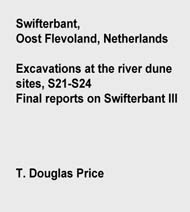Swifterbant
Excavations at the river dune sites, S21-S24
Final reports on Swifterbant III
T. Douglas Price
Uitgegeven door de Universiteit van Groningen, 1976
Continuing investigations in the Swifterbant area over the last twenty years have resulted in the
recovery of the remains of human occupation dating from both the Mesolithic and the Neolithic periods.
The somewhat higher elevations of the river dunes appear to have been favored locales for habitation.
During the Boreal period of the early Postglacial, this area would have been a fairly typical coversand
environment in a riverine regime. The landscape would have been dominated by a relatively stable Boreal
forest. As conditions became moister and sea level rose after 5500 B.C. in the Atlantic period, the area
was transformed into a bog and creek system in a fresh water tidal delta environment.
A marsh forest would have been present with much alder, oak, and pine. Lime trees would have been common
on the river dunes (Casparie et al., 1977). Finally the area would have been inundated by rising water
levels sometime after 3000 B.C.
Deze studie is als een PDF te downloaden van
RUG.nl

